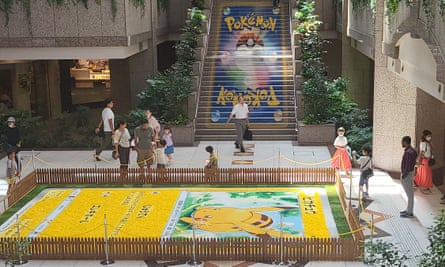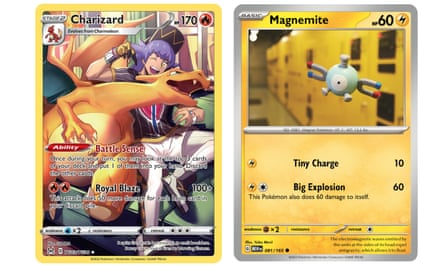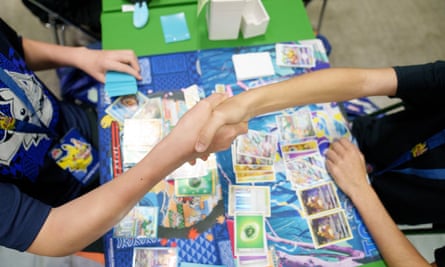The hidden processes behind the creation of Pokémon cards – from sculpting with clay to intense testing.
T
In Yokohama, Japan this year, the streets were adorned with oversized Pokémon cards. These cards ranged from valuable holographics displayed on glass walls to a Pikachu card the size of a small garden. Even the floors of the city’s shopping centers were covered in images of common creatures, celebrating the popular Pokémon trading card game. Meanwhile, at the Pacifico convention center, top players from around the globe competed in the annual world championships.
To date, a total of nine billion cards have been created. Out of those, 21% were produced after 2021 and have been sold in 76 countries, available in 13 different languages. These cards were incredibly popular in playgrounds during the 2000s, to the point where they were frequently prohibited in schools. This trend is resurfacing now as the cards have experienced a surge in demand during the pandemic, particularly among bored children and nostalgic millennials. In July 2021, YouTuber Logan Paul made headlines for purchasing a single card for $5 million.

The company, Creatures Inc, is known for being secretive. Located near Tokyo’s Imperial Palace, their building is a dream for fans of Japanese culture. The lobby features a large wooden deck with a beautiful view of a field of water lilies, their green tendrils swaying in the breeze. Riding up in the elevator, it’s easy to imagine hidden creatures scurrying around the plants under the palace’s shadow. Inside, there are impressive black and white 3D art installations inspired by Pokémon, along with bold and modern recreations of Blastoise and Charizard cards, complete with crystal accents and thick ceramic edges. The walls are also decorated with empty card shells.
The creators of each new card set explain that it takes a year to develop, from the core concept to the final printed designs. According to TCG game director Atsushi Nagashima, the trading card game follows the logic of the new Pokémon and their video game mechanics whenever new game software is released. Nagashima is responsible for determining the rules of the card game, ensuring that card battles remain enjoyable and fair.
A lot of people who collect Pokémon cards don’t actually use them in competitions, but Nagashima doesn’t have a problem with that. He believes that there are many ways to enjoy Pokémon cards and it’s acceptable to just collect them without playing. The true appeal of the card game is the love for Pokémon itself, and for many people, collecting the cards is simply enjoyable. It captures the essence of being a child, where you have fun exploring, catching, and playing outside. That’s why Nagashima believes that the Pokémon TCG has been loved by people of all ages.
Nagashima states that the game is always evolving, with a focus on improving the art cards to capture the essence of the Pokémon and their personalities.
Creatures Inc has a team of more than 240 independent artists. Their goal is to ensure that each Pokémon card has a unique appearance. The artwork on these cards ranges from traditional anime-inspired designs to more surreal and trippy interpretations of Pokémon. This captivating art is a major factor in why people are willing to invest large amounts of money in booster packs.
“We constantly strive to diversify the artist styles,” states Haru Saito, director of illustration, with three of Pokémon’s most adored artists by her side. “Therefore, we engage in lively discussions to determine the most suitable artists for each card. Our goal is to continuously bring fresh surprises and innovative illustration styles in order to maintain the appeal of the cards.”
Gidora, a recent addition to the company’s roster of artists, has gained recognition for his unique cards that highlight the bond between trainers and their Pokémon. In an interview, he expresses his goal of expanding the rich lore of the Pokémon universe through his artwork, drawing upon stories he imagined as a child. He believes that illustration can bring a fresh perspective to the playful world of Pokémon.
Reworded:
Saito explains that artists are hired to add their personal touch to Pokémon designs. She believes in allowing creative freedom for each individual, resulting in unique and distinctive cards. Yuka Morii stands out as a prime example of this. While other artists use pens or paint brushes, she sculpts her designs from clay. With great care, she shapes her Pokémon and then photographs them in real-life settings for the card frames, bringing her chosen characters to life.

The work of illustrators is prominently featured on Pokémon cards, but there is also a significant amount of behind-the-scenes effort put into maintaining balance in competitive play. This responsibility falls on the shoulders of Creatures Inc’s game testers, who often go unrecognized for their contributions. Whenever a new card is created, these 18 Pokémon experts diligently playtest it to ensure its effectiveness. Their job consists of playing with Pokémon cards every day.
In contrast to video games, where a problematic feature can be easily corrected with a patch, mistakes in printed cards are permanent. Therefore, the goal is to prevent any game-breaking flaws by extensively testing each new prototype against numerous deck combinations to ensure a fair and balanced gameplay experience.
Ignore the newsletter promotion and proceed.
after newsletter promotion

Cards in general take one to two months to test, grinning testers Kohei Kobayashi and Satoru Inoue tell me. The best case scenario? A card makes it through the test process in just three weeks. Playing four games an hour, their work days see them engaging in at least seven hours of rigorous battling. They constantly laugh and joke around throughout our chat, oozing an infectiously university-flatmate-esque camaraderie.
How, you may wonder, does one become one of these 18 Pokémon testers? “Through passion and knowledge!” says a smiling Kobayashi. “The candidate of course has to know all the details of all the cards – or just be capable of studying to learn all the details.”
Interestingly, Kobayashi explains that the game designers make a point of never hiring pro players. “I never hire or scout anyone at the world championships, because I want to leave the strong players as they are.” He adds: “They really shine when they are out there competing, so I don’t want to ruin that.”
Nagashima takes great joy in observing players immerse themselves in the world of competitive gaming. Witnessing the multitude of cards spread throughout Yokohama for this year’s championships was a proud moment for him. “It’s truly remarkable. I have been attending the world championships since 2004,” he shares. “Watching individuals compete greatly inspires me, and I’m fortunate to have gym battles near my home where I can frequently observe others playing.”

The rise in popularity of board and card games like Magic the Gathering has led to an increase in competition for Pokémon. Disney has recently released their own game, Lorcana, in partnership with Ravensburger, which showcases artwork from their vast collection of films. However, Nagashima remains unperturbed. He suggests that instead of relying solely on data and analysis, card creators should focus on the gameplay experience and the enjoyment it brings to players.
All the people I’ve talked to from Creatures Inc seem to love their job, just as much as people love the cards. Morii, with a smile on her face, mentioned that she receives fan mail almost every day. Gidora, who has been a fan of the TCG since its first expansion, feels like he’s fulfilling a lifelong dream.
When I was younger, I would often wonder about the emotions of the illustrators who were selected to create artwork for Pokémon. Now, I am filled with immense pride,” he explains. “I strive to create work that can also inspire others and bring the same joy to kids that I experienced while collecting Pokémon cards.”
Source: theguardian.com

